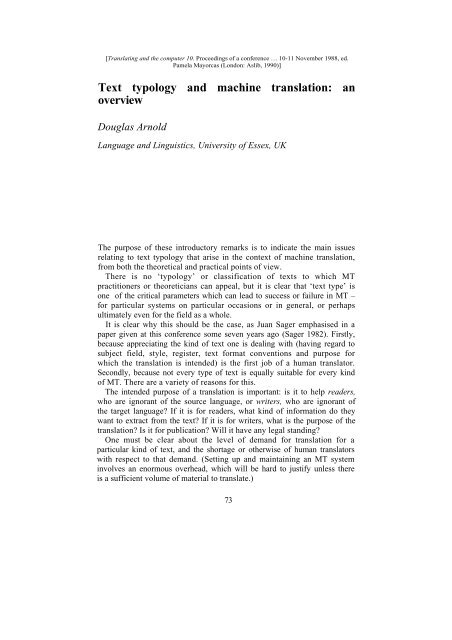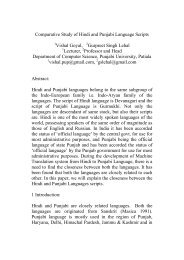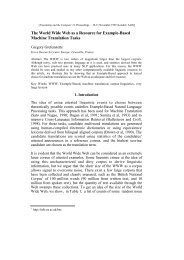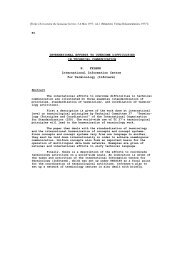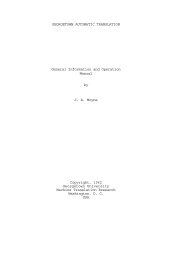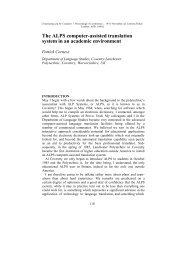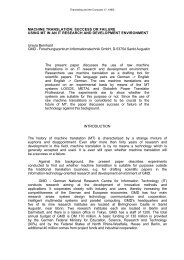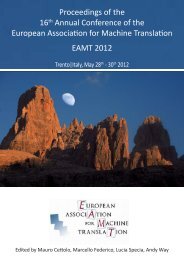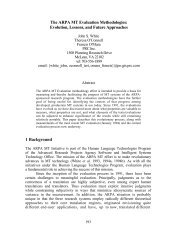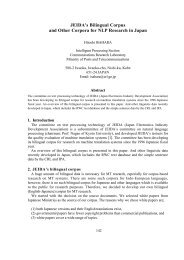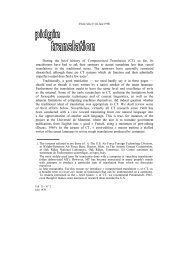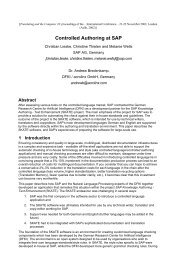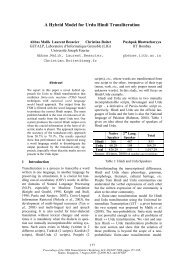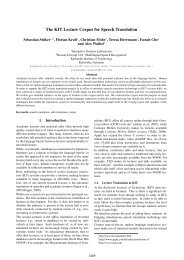Text typology and machine translation: an overview
Text typology and machine translation: an overview
Text typology and machine translation: an overview
You also want an ePaper? Increase the reach of your titles
YUMPU automatically turns print PDFs into web optimized ePapers that Google loves.
[Tr<strong>an</strong>slating <strong><strong>an</strong>d</strong> the computer 10. Proceedings of a conference … 10-11 November 1988, ed.<br />
Pamela Mayorcas (London: Aslib, 1990)]<br />
<strong>Text</strong> <strong>typology</strong> <strong><strong>an</strong>d</strong> <strong>machine</strong> <strong>tr<strong>an</strong>slation</strong>: <strong>an</strong><br />
<strong>overview</strong><br />
Douglas Arnold<br />
L<strong>an</strong>guage <strong><strong>an</strong>d</strong> Linguistics, University of Essex, UK<br />
The purpose of these introductory remarks is to indicate the main issues<br />
relating to text <strong>typology</strong> that arise in the context of <strong>machine</strong> <strong>tr<strong>an</strong>slation</strong>,<br />
from both the theoretical <strong><strong>an</strong>d</strong> practical points of view.<br />
There is no ‘<strong>typology</strong>’ or classification of texts to which MT<br />
practitioners or theoretici<strong>an</strong>s c<strong>an</strong> appeal, but it is clear that ‘text type’ is<br />
one of the critical parameters which c<strong>an</strong> lead to success or failure in MT –<br />
for particular systems on particular occasions or in general, or perhaps<br />
ultimately even for the field as a whole.<br />
It is clear why this should be the case, as Ju<strong>an</strong> Sager emphasised in a<br />
paper given at this conference some seven years ago (Sager 1982). Firstly,<br />
because appreciating the kind of text one is dealing with (having regard to<br />
subject field, style, register, text format conventions <strong><strong>an</strong>d</strong> purpose for<br />
which the <strong>tr<strong>an</strong>slation</strong> is intended) is the first job of a hum<strong>an</strong> tr<strong>an</strong>slator.<br />
Secondly, because not every type of text is equally suitable for every kind<br />
of MT. There are a variety of reasons for this.<br />
The intended purpose of a <strong>tr<strong>an</strong>slation</strong> is import<strong>an</strong>t: is it to help readers,<br />
who are ignor<strong>an</strong>t of the source l<strong>an</strong>guage, or writers, who are ignor<strong>an</strong>t of<br />
the target l<strong>an</strong>guage? If it is for readers, what kind of information do they<br />
w<strong>an</strong>t to extract from the text? If it is for writers, what is the purpose of the<br />
<strong>tr<strong>an</strong>slation</strong>? Is it for publication? Will it have <strong>an</strong>y legal st<strong><strong>an</strong>d</strong>ing?<br />
One must be clear about the level of dem<strong><strong>an</strong>d</strong> for <strong>tr<strong>an</strong>slation</strong> for a<br />
particular kind of text, <strong><strong>an</strong>d</strong> the shortage or otherwise of hum<strong>an</strong> tr<strong>an</strong>slators<br />
with respect to that dem<strong><strong>an</strong>d</strong>. (Setting up <strong><strong>an</strong>d</strong> maintaining <strong>an</strong> MT system<br />
involves <strong>an</strong> enormous overhead, which will be hard to justify unless there<br />
is a sufficient volume of material to tr<strong>an</strong>slate.)<br />
73
74 Tr<strong>an</strong>slating <strong><strong>an</strong>d</strong> the Computer 10<br />
Some kinds of text are inherently difficult for MT. They may contain<br />
syntactic <strong><strong>an</strong>d</strong> morphological constructions which, if they c<strong>an</strong>not be<br />
eliminated, are problematic for all kinds of natural l<strong>an</strong>guage processing<br />
(for example, N-N compounding, co-ordination, ellipsis, ‘unbounded<br />
dependencies’, the need for extensive resolution of pronominal<br />
reference 1 ). <strong>Text</strong>s may be more or less well-behaved (e.g. free of mistakes<br />
such as typing <strong><strong>an</strong>d</strong> spelling mistakes); more or less restricted, or ‘open<br />
ended’ (e.g. open to extended or metaphorical l<strong>an</strong>guage uses). Thus,<br />
poetry is difficult to tr<strong>an</strong>slate, <strong><strong>an</strong>d</strong> weather reports are not.<br />
Of course, asking these questions in relation to MT, as though that<br />
itself were a single thing, oversimplifies matters. One should be asking<br />
the question about different kinds of MT. But the general point remains –<br />
the practical success or otherwise of MT depends on matching up:<br />
- the capabilities of current <strong><strong>an</strong>d</strong> projected MT systems<br />
- the needs <strong><strong>an</strong>d</strong> purposes for <strong>tr<strong>an</strong>slation</strong><br />
- the inherent properties of texts to be h<strong><strong>an</strong>d</strong>led by MT.<br />
When this equation is correct, as with METEO, the result is practical<br />
success.<br />
I do not know of <strong>an</strong>y work that seeks to provide a principled<br />
classification of texts in terms of ‘dem<strong><strong>an</strong>d</strong> for’ versus ‘availability of<br />
<strong>tr<strong>an</strong>slation</strong>’, or of the purposes for which <strong>tr<strong>an</strong>slation</strong>s are intended, <strong><strong>an</strong>d</strong><br />
this is not the place to discuss the capacities <strong><strong>an</strong>d</strong> limitations of MT<br />
systems (even where these are known). Instead, I will direct the<br />
remaining space to the theoretical <strong><strong>an</strong>d</strong> practical issues that arise from<br />
restrictions on the inherent properties of texts.<br />
The inherent properties which c<strong>an</strong> be restricted seem to be the<br />
following:<br />
1. SEMANTIC DOMAIN (domain of discourse/subject field). The texts<br />
to be tr<strong>an</strong>slated c<strong>an</strong> be restricted to ones dealing with, for example,<br />
weather reports, stock market or medical reports, magazine<br />
horoscopes, recipes, knitting patterns, word processor<br />
documentation, engineering or aviation m<strong>an</strong>uals.<br />
2. OVERALL DISCOURSE TYPE (this alone is sometimes called ‘text<br />
type’). <strong>Text</strong>s may be restricted to those that have a particular<br />
internal format or structure, for example, business letters,<br />
newspaper stories, technical abstracts, patent applications, legal or<br />
governmental proclamations.<br />
3. DISCOURSE STRUCTURE. <strong>Text</strong>s may be such that they exclude, for<br />
example, pronominal references outside the sentence, or<br />
paragraph; that headings may always be noun phrases; that<br />
‘descriptive’ <strong><strong>an</strong>d</strong> ‘imperative’ sections of text may be clearly<br />
separated.
<strong>Text</strong> <strong>typology</strong> <strong><strong>an</strong>d</strong> <strong>machine</strong> <strong>tr<strong>an</strong>slation</strong> 75<br />
4. SYNTAX AND MORPHOLOGY. The r<strong>an</strong>ge of syntactic constructions<br />
may be limited such that they exclude all but declarative <strong><strong>an</strong>d</strong><br />
imperative sentences; restrict N-N compounds to those which are<br />
listed as single items; limit the kinds of co-ordination that are<br />
allowed.<br />
5. LEXIS. The vocabulary used may be limited in terms of the number<br />
of distinct words that c<strong>an</strong> be used, or in terms of the r<strong>an</strong>ge of uses or<br />
readings of each word e.g., the Concise Oxford English Dictionary<br />
assigns the verb ‘press’ 10 distinct senses, <strong><strong>an</strong>d</strong> the noun <strong>an</strong>other<br />
seven, but in a word processor m<strong>an</strong>ual it will almost certainly be<br />
possible to limit the usage to the verbal me<strong>an</strong>ing ‘to exert pressure<br />
on’ as in ‘Press (the) return (key)’.<br />
If one c<strong>an</strong> find texts which observe these restrictions, <strong><strong>an</strong>d</strong> if, in<br />
addition, one c<strong>an</strong> see that the (restricted) l<strong>an</strong>guage in which these texts are<br />
written is a true l<strong>an</strong>guage in the sense of being systematic, productive<br />
(creatively usable), used by some community, adequate for its intended<br />
purpose, etc. then one has a subl<strong>an</strong>guage, <strong><strong>an</strong>d</strong> the ch<strong>an</strong>ces of a successful<br />
application of (some form of) MT are particularly good 2 .<br />
To get some idea of how good, one only has to consider lexicon. A<br />
typical large general dictionary contains approximately 400,000 words;<br />
Lehrberger (1982 p83) suggested that the aviation m<strong>an</strong>uals studied in the<br />
TAUM-AVIATION project contained around 40,000 <strong><strong>an</strong>d</strong> that for<br />
agriculture market reports the number may be as low as a few hundred<br />
words (the METEO dictionary contains less th<strong>an</strong> 1,000 words [Kittredge<br />
1982 p124]). A <strong>tr<strong>an</strong>slation</strong> system for the general l<strong>an</strong>guage covered by a<br />
normal dictionary would be <strong>an</strong> enormous undertaking, but one whose<br />
lexicon contains only a few hundred words looks distinctly feasible.<br />
However, there are still some interesting practical <strong><strong>an</strong>d</strong> theoretical<br />
problems 3 :<br />
1. What is the relation between a subl<strong>an</strong>guage <strong><strong>an</strong>d</strong> a general l<strong>an</strong>guage?<br />
It is a matter of definition that there are words <strong><strong>an</strong>d</strong> constructions in the<br />
general l<strong>an</strong>guage that are not part of the subl<strong>an</strong>guage. However, (despite<br />
the name) it does not follow that a subl<strong>an</strong>guage forms a subset of the<br />
general l<strong>an</strong>guage. In particular, it is often the case that there are<br />
constructions in the subl<strong>an</strong>guage that are at best marginal in the general<br />
l<strong>an</strong>guage. For example, it is common in instruction m<strong>an</strong>uals to find<br />
locutions of the form: confirm high tension circuit complete (that is, confirm<br />
[that the] high tension circuit is complete). This construction is found in<br />
the general l<strong>an</strong>guage (cf ‘I believe the high tension circuit complete’), but<br />
not with the verb confirm (Lehrberger 1982 p90). The practical point here<br />
is that, to be useful, a subl<strong>an</strong>guage must not just exclude some<br />
constructions, it must exclude some difficult constructions, <strong><strong>an</strong>d</strong> <strong>an</strong>y<br />
marginal constructions it includes must not themselves be too difficult.
76 Tr<strong>an</strong>slating <strong><strong>an</strong>d</strong> the Computer 10<br />
2. What is the relation between the grammar of the subl<strong>an</strong>guage <strong><strong>an</strong>d</strong><br />
that of the general l<strong>an</strong>guage? Here the <strong>an</strong>swer is clear: there is no necessity<br />
for the grammar of a subl<strong>an</strong>guage to bear <strong>an</strong>y interesting resembl<strong>an</strong>ce to<br />
that of the general l<strong>an</strong>guage. TAUM-METEO recognises five main<br />
‘sentence’ types (Lehrberger 1982 p100), none of which remotely<br />
resembles the rules conventionally assumed for English. Given that the<br />
system designer may not have a ‘native-speaker-like’ grasp of the<br />
subl<strong>an</strong>guage, writing a subl<strong>an</strong>guage grammar poses obvious practical <strong><strong>an</strong>d</strong><br />
methodological problems <strong><strong>an</strong>d</strong> the theoretical problem of automatically<br />
inferring grammars from collections of texts becomes interesting<br />
(Hirschm<strong>an</strong> 1986, Slocum 1986).<br />
3. What kinds of relation are there between different subl<strong>an</strong>guages<br />
within one general l<strong>an</strong>guage? (For example, is there <strong>an</strong>y interesting<br />
relation between the l<strong>an</strong>guage of weather reports <strong><strong>an</strong>d</strong> the l<strong>an</strong>guage of<br />
stock market reports?) The corresponding practical question relates to<br />
the (non-) portability of subl<strong>an</strong>guage systems.<br />
4. Given that subl<strong>an</strong>guage grammars may differ from each other, <strong><strong>an</strong>d</strong><br />
from the grammar of the general l<strong>an</strong>guage, does this me<strong>an</strong> there are<br />
different roles for, for example, morphology, syntax, sem<strong>an</strong>tics, <strong><strong>an</strong>d</strong> for<br />
the relationship of <strong>an</strong>alysis, generation, (<strong><strong>an</strong>d</strong> if appropriate, tr<strong>an</strong>sfer)?<br />
That is, are different architectures appropriate for subl<strong>an</strong>guage<br />
<strong>tr<strong>an</strong>slation</strong> systems?<br />
The practical import<strong>an</strong>ce of points 1 to 4 c<strong>an</strong> be summarised as follows:<br />
- one c<strong>an</strong>not guar<strong>an</strong>tee that <strong>an</strong>y system, or part of a system, which has<br />
been developed for one domain will be suitable for a different<br />
subl<strong>an</strong>guage (or, if it is suitable, that it will be ‘good’);<br />
There are import<strong>an</strong>t practical problems in:<br />
- discovering the restrictions that a subl<strong>an</strong>guage observes<br />
- exploiting them.<br />
5. What kinds of relation are there between the subl<strong>an</strong>guage of one<br />
general l<strong>an</strong>guage, <strong><strong>an</strong>d</strong> those of <strong>an</strong>other: is the English l<strong>an</strong>guage of<br />
instruction m<strong>an</strong>uals closely related to that of French instruction m<strong>an</strong>uals<br />
(similarly for Jap<strong>an</strong>ese, Thai, Swahili, etc.)? Interestingly, there is<br />
considerable evidence that they are similar (see Kittredge 1982a, Teller,<br />
Kosaka <strong><strong>an</strong>d</strong> Grishm<strong>an</strong> 1988). But if they are similar, why are they similar?<br />
Is it a result of contact between the communities who use the<br />
subl<strong>an</strong>guage, or is it somehow a result of pressure from the sem<strong>an</strong>tic<br />
domain?<br />
6. In general, neither subl<strong>an</strong>guages, nor texts written in them are<br />
completely ‘closed’. Subl<strong>an</strong>guages (like all l<strong>an</strong>guages) are to some extent<br />
‘permeable’, <strong><strong>an</strong>d</strong> typically allow ‘escapes’ into the more general l<strong>an</strong>guage.<br />
For example, a text, or section of text that is basically imperative may<br />
contain stretches of description; a description of a drugs trial which is
<strong>Text</strong> <strong>typology</strong> <strong><strong>an</strong>d</strong> <strong>machine</strong> <strong>tr<strong>an</strong>slation</strong> 77<br />
basically restricted to a technical l<strong>an</strong>guage <strong><strong>an</strong>d</strong> vocabulary, may at some<br />
point, describe everyday occurrences that affected a subject, <strong><strong>an</strong>d</strong> the<br />
vocabulary here will be quite unpredictable. Import<strong>an</strong>t questions are<br />
then: How ‘permeable’ is <strong>an</strong>y given subl<strong>an</strong>guage to more general usage?<br />
Is there <strong>an</strong>y way of (automatically) recognising whether a particular<br />
stretch of text is ‘general’ or ‘sublingual’?<br />
7. Finally, the most obvious practical problem that arises for <strong>an</strong>yone<br />
who w<strong>an</strong>ts to exploit the apparent suitability of subl<strong>an</strong>guages for MT is<br />
the problem of discovering (or successfully defining) one. It is easy<br />
enough to enumerate sem<strong>an</strong>tic domains but there is no guar<strong>an</strong>tee that<br />
there will be associated restrictions on discourse, syntax, morphology <strong><strong>an</strong>d</strong><br />
lexis 4 . Practically speaking, given a proposal for a subl<strong>an</strong>guage (say a<br />
particular sem<strong>an</strong>tic domain), how c<strong>an</strong> one investigate how tractable it is<br />
likely to be? (see Kittredge 1986).<br />
CONCLUSION<br />
It is clear from what I have said that, for practical MT, restrictions on<br />
text-type, including the limiting case of subl<strong>an</strong>guages, represent a major<br />
line of adv<strong>an</strong>ce. Moreover, because I think practical experience is a<br />
necessary pre-requisite for theoretical adv<strong>an</strong>ce, the same goes for MT<br />
research. But I would like to enter a caveat.<br />
There is a real d<strong>an</strong>ger in restricting the inherent properties of the texts<br />
that one deals with: the d<strong>an</strong>ger that one will not be able to generalise from<br />
that type of text to the more general l<strong>an</strong>guage (or even to <strong>an</strong>y other<br />
restricted domain); the d<strong>an</strong>ger that the restrictions hide essential aspects<br />
of the ‘problem of <strong>tr<strong>an</strong>slation</strong>’. In particular, the interest <strong><strong>an</strong>d</strong> import<strong>an</strong>ce<br />
of subl<strong>an</strong>guage-based MT should not be allowed to obscure the value of<br />
what one might call ‘theoretically-based’ or ‘phenomena-based’ work in<br />
MT: work which begins with <strong>an</strong> idea about <strong>tr<strong>an</strong>slation</strong>, or studies the<br />
problems that arise in tr<strong>an</strong>slating a particular construction, <strong><strong>an</strong>d</strong> which<br />
pursues that idea or construction in the full glory <strong><strong>an</strong>d</strong> awfulness of dealing<br />
with relatively unrestricted ‘general’ l<strong>an</strong>guage.<br />
NOTES<br />
1. The following are examples of some of these:<br />
(a) N-N (noun-noun) compounds:<br />
Replacement exhaust service centre personnel m<strong>an</strong>ager.<br />
(b) Ellipsis:<br />
Comp<strong>an</strong>y A gave the men a bonus, Comp<strong>an</strong>y B . . . a pay rise.<br />
(c) Unbounded dependency – there is a dependency between two items, for<br />
example, a verb <strong><strong>an</strong>d</strong> its object, but they c<strong>an</strong> be separated by <strong>an</strong> unbounded<br />
dist<strong>an</strong>ce, in the sense that there c<strong>an</strong> be <strong>an</strong> unlimited number of intervening<br />
sentences:
78 Tr<strong>an</strong>slating <strong><strong>an</strong>d</strong> the Computer 10<br />
They do not employ people who (s the police suspect . . . )<br />
They do not employ people who (s they know [s the police suspect. . . . ] )<br />
They do not employ people who (s they know [s other comp<strong>an</strong>ies think (s<br />
the police suspect. . . )]).<br />
2. The restrictions in question may be imposed (for example, by a style sheet),<br />
or arise spont<strong>an</strong>eously (<strong><strong>an</strong>d</strong> so be ‘discovered’) in a family of texts (for<br />
example, as a result of a group of writers dealing with similar subject matter<br />
with similar aims <strong><strong>an</strong>d</strong> intentions). This does not matter so long as what result<br />
c<strong>an</strong> be considered to be a ‘l<strong>an</strong>guage’ in this sense.<br />
To be ped<strong>an</strong>tic, a further requirement is that to constitute a subl<strong>an</strong>guage, a<br />
set of texts must be ‘maximal’ in the sense of being the largest set that satisfies<br />
the relev<strong>an</strong>t restrictions. The point is that a subl<strong>an</strong>guage is not <strong>an</strong> arbitrary<br />
collection of texts, <strong><strong>an</strong>d</strong> texts must not be arbitrarily excluded. This me<strong>an</strong>s<br />
that new texts belonging to a subl<strong>an</strong>guage c<strong>an</strong> always be produced, so a<br />
subl<strong>an</strong>guage is not generally a finite collection of texts.<br />
It is sometimes said that MT systems deal with subl<strong>an</strong>guages by definition.<br />
This is because the properties of the texts that c<strong>an</strong> be automatically tr<strong>an</strong>slated<br />
are controlled by definition: <strong>an</strong> MT system defines (at least) two l<strong>an</strong>guages (a<br />
l<strong>an</strong>guage it will accept, <strong><strong>an</strong>d</strong> a l<strong>an</strong>guage it will generate) <strong><strong>an</strong>d</strong> the relation<br />
between them. These l<strong>an</strong>guages are restricted <strong><strong>an</strong>d</strong> well-defined, in general.<br />
This is true, if by ‘subl<strong>an</strong>guage’ we me<strong>an</strong> (roughly) some controlled subset of<br />
a natural l<strong>an</strong>guage. However, as will be clear, I think the term is usefully<br />
applied in a rather more precise <strong><strong>an</strong>d</strong> narrow way.<br />
3. These problems arise to some extent with <strong>an</strong>y restrictions on text type,<br />
whether or not they are sufficient to yield a subl<strong>an</strong>guage. See the articles in<br />
Kittredge <strong><strong>an</strong>d</strong> Lehrberger (1982), <strong><strong>an</strong>d</strong> Grishm<strong>an</strong> <strong><strong>an</strong>d</strong> Kittredge (1986) for<br />
detailed discussion of these <strong><strong>an</strong>d</strong> other problems; Kittredge (1986) provides <strong>an</strong><br />
<strong>overview</strong>.<br />
4. Notice that the existence of a subl<strong>an</strong>guage of (say) English does not guar<strong>an</strong>tee<br />
that there will be <strong>an</strong> equivalent in <strong>an</strong>y other l<strong>an</strong>guage.<br />
REFERENCES<br />
Hirschm<strong>an</strong>, L. (1986) ‘Discovering subl<strong>an</strong>guage structures’ in Grishm<strong>an</strong><br />
<strong><strong>an</strong>d</strong> Kittredge (eds.) 211-234.<br />
Grishm<strong>an</strong>, R. <strong><strong>an</strong>d</strong> Kittredge, R.I. (eds) Analyzing l<strong>an</strong>guage in restricted<br />
domains: subl<strong>an</strong>guage description <strong><strong>an</strong>d</strong> processing New Jersey: Hillsdale,<br />
Lawrence Erlbaum Associates, 1986.<br />
Kittredge, R.I. (1982) ‘Variation <strong><strong>an</strong>d</strong> homogeneity of subl<strong>an</strong>guages’ in<br />
Kittredge <strong><strong>an</strong>d</strong> Lehrberger (eds) 107-137.<br />
Kittredge, R.I. (1986) ‘The signific<strong>an</strong>ce of subl<strong>an</strong>guage for automatic<br />
<strong>tr<strong>an</strong>slation</strong>’ in Nirenburg, S. (ed.) Machine <strong>tr<strong>an</strong>slation</strong> systems<br />
Cambridge: Cambridge University Press, 1987, 59-67.<br />
Kittredge, R.I. <strong><strong>an</strong>d</strong> Lehrberger, J. 1982 (eds) Subl<strong>an</strong>guage, Berlin:<br />
Walter de Gruyter.
<strong>Text</strong> <strong>typology</strong> <strong><strong>an</strong>d</strong> <strong>machine</strong> <strong>tr<strong>an</strong>slation</strong> 79<br />
Lehrberger, J. 1982 ‘Automatic <strong>tr<strong>an</strong>slation</strong> <strong><strong>an</strong>d</strong> the concept of<br />
subl<strong>an</strong>guage’ in Kittredge <strong><strong>an</strong>d</strong> Lehrberger (eds), 81-107.<br />
Sager, J.C. 1982 ‘Types of <strong>tr<strong>an</strong>slation</strong> <strong><strong>an</strong>d</strong> text forms in the environment<br />
of <strong>machine</strong> <strong>tr<strong>an</strong>slation</strong> (MT)’ in V. Lawson (ed). Practical experience of<br />
<strong>machine</strong> <strong>tr<strong>an</strong>slation</strong> Dordrecht: North Holl<strong><strong>an</strong>d</strong> Publishing Co, 11-19.<br />
Slocum, J. 1986 ‘How one might identify <strong><strong>an</strong>d</strong> adapt to a subl<strong>an</strong>guage: <strong>an</strong><br />
initial exploration’ in Grishm<strong>an</strong> <strong><strong>an</strong>d</strong> Kittredge (eds) 195-210.<br />
Teller, V. Kosaka, M. <strong><strong>an</strong>d</strong> Grishm<strong>an</strong>, R. 1988 ‘A comparative study of<br />
Jap<strong>an</strong>ese <strong><strong>an</strong>d</strong> English subl<strong>an</strong>guage patterns’ in S. Nirenburg (ed.)<br />
Proceedings of the second conference on theoretical <strong><strong>an</strong>d</strong> methodological issues<br />
in MT Carnegie Mellon University, Pittsburg, Pa., 1987<br />
AUTHOR<br />
Douglas Arnold, University of Essex, Department of L<strong>an</strong>guage <strong><strong>an</strong>d</strong><br />
Linguistics, Wivenhoe Park, Colchester, Essex.


